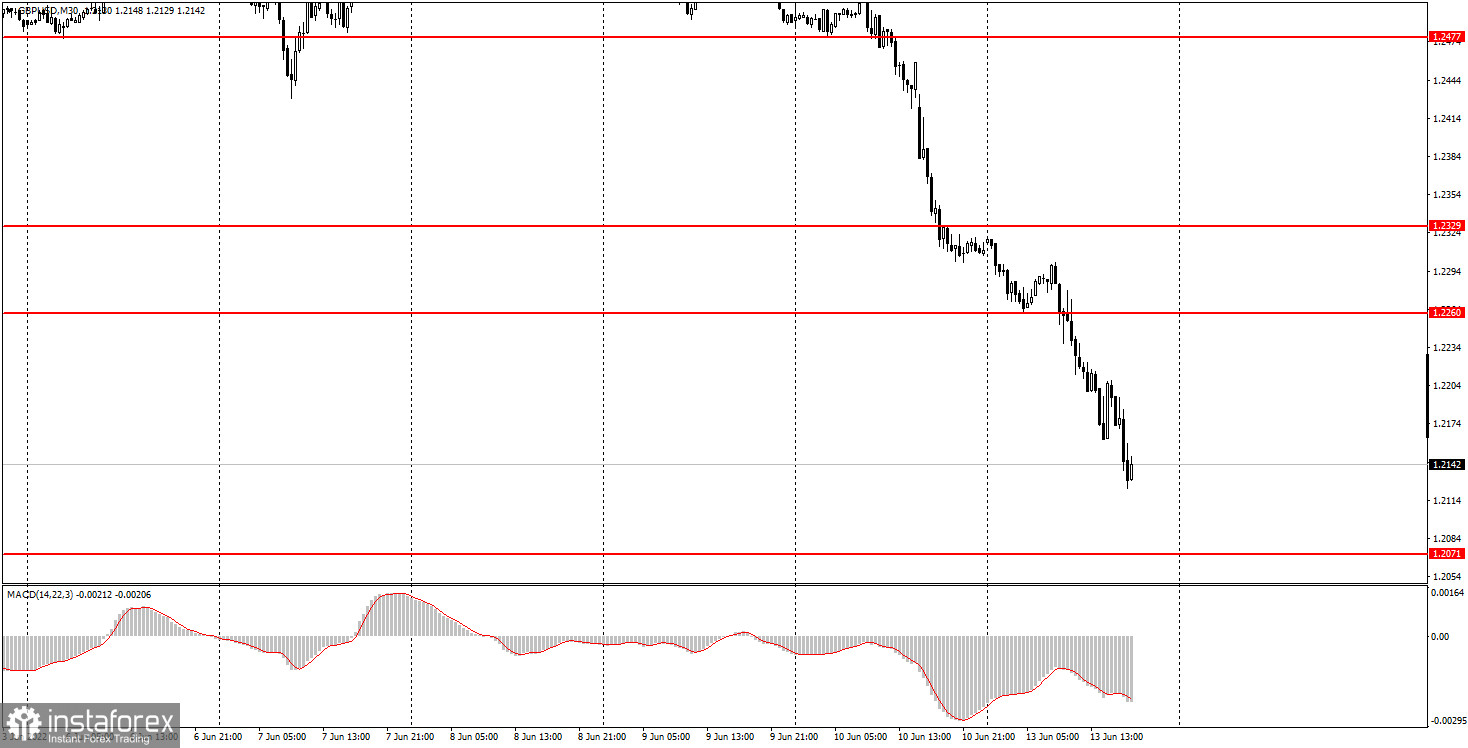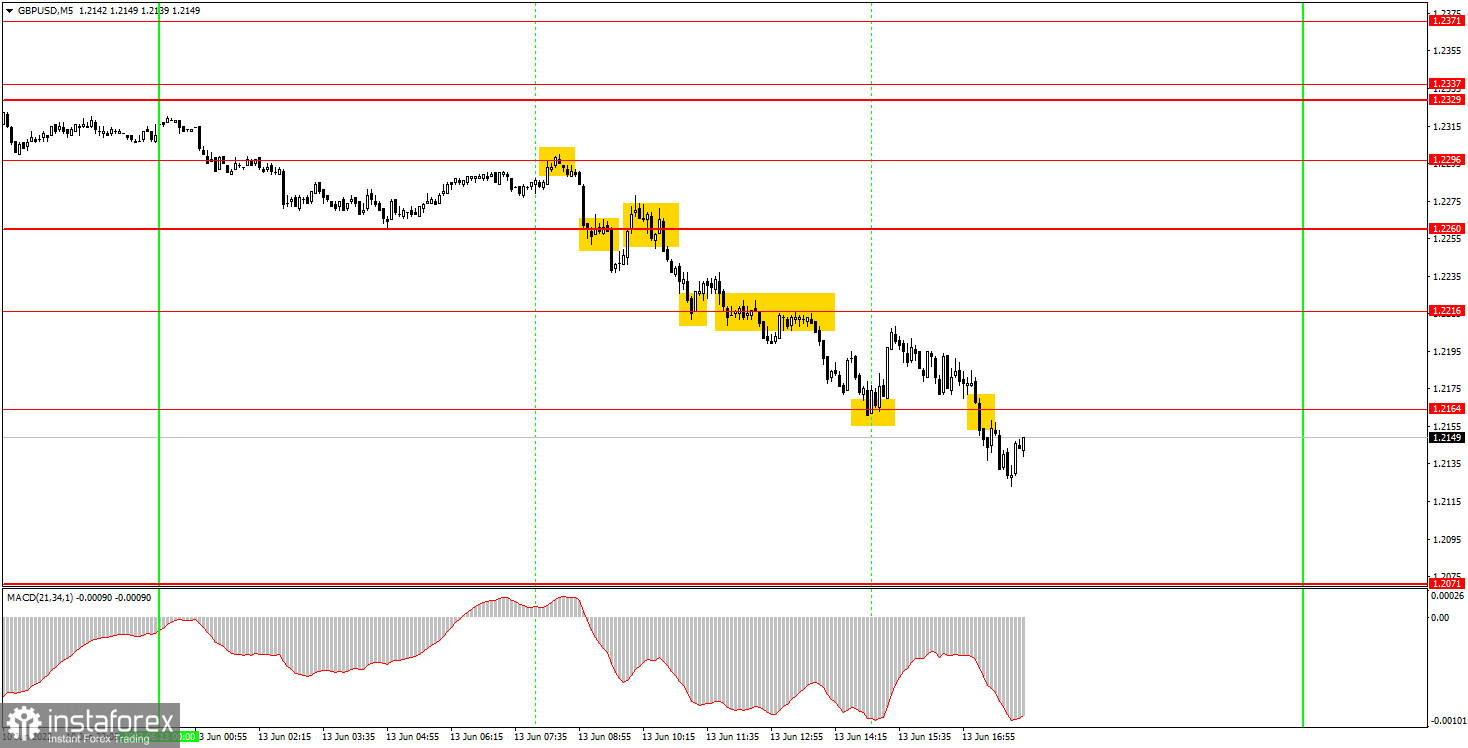Analysis of Monday's deals:
30M chart of the GBP/USD pair

Yesterday, the GBP/USD pair continued not just a fall, but a landslide decline. Volatility of the day was almost 200 points, and the pound started to fall at night. Thus, the pound fell just like that, by inertia, and due to the disappointing report on the British GDP, which showed a contraction of 0.3% in April, altogether. It should be noted right away that the report on GDP could really strengthen the bearish mood of traders. However, the pound would most likely have fallen even without this report, as the euro did. After Friday's inflation report, which significantly increased the likelihood of a Federal Reserve rate hike not by 0.5% in June, but immediately by 0.75%, the dollar is growing by leaps and bounds. This is precisely the chance for the euro and the pound. If traders have already won back a future 0.75% rate hike, then if the Fed announces a 0.5% hike on Thursday, the dollar could fall very badly. It is also possible that the market has simply worked out any increase, so it will simply not buy the dollar. In any case, we are in for a very active week, as it will also include the Bank of England meeting.
5M chart of the GBP/USD pair

A lot of trading signals were formed on the 5-minute timeframe. First, the price rebounded from the level of 1.2296, forming a sell signal. Then it overcame the 1.2260 level, after which the price rebounded from it from the bottom not very accurately – two more sell signals. Only one trade should have been opened on these signals, near the level of 1.2296. A short position should have been closed near the level of 1.2216, since the price initially rebounded from it. Unfortunately, this rebound spoiled the whole picture. It was possible to make a profit on the first short position (50 points), but this rebound was also a signal to buy, so it was necessary to open a long position, which turned out to be unprofitable, because the price settled below the level of 1.2216 almost immediately. But there is good news, consolidating below the level of 1.2261 was a signal to sell, which means it was necessary to sell again. This trade closed near the 1.2164 level, from which the price also bounced. After a buy signal, it was able to go up 30 points, so novice traders had the opportunity to set Stop Loss to breakeven. The most recent sell signal should not have been worked out, since it was formed too late. As a result, two transactions are profitable, one is unprofitable.
How to trade on Tuesday:
The pound's sharp decline continues on the 30-minute timeframe. And it is very difficult to guess what will happen next, since the meetings of the Bank of England and the Fed will be held on Wednesday and Thursday, and these are the most important events in the foreign exchange market. The volatility of the pair is already the highest, and it could be even higher on Wednesday and Thursday. The most important thing to remember is to be cautious these days. On the 5-minute TF, it is recommended to trade at the levels 1.2071, 1.2164, 1.2216, 1.2260, 1.2296, 1.2329-1.2337. When the price passes after opening a deal in the right direction for 20 points, Stop Loss should be set to breakeven. No major events are planned for tomorrow in the UK and America. Novice traders had nothing to react to during the day. We expected a correction on Monday, but did not wait for it. So now we will wait for it on Tuesday. However, a fall in the pound remains the most likely option.
Basic rules of the trading system:
1) The signal strength is calculated by the time it took to form the signal (bounce or overcome the level). The less time it took, the stronger the signal.
2) If two or more deals were opened near a certain level based on false signals (which did not trigger Take Profit or the nearest target level), then all subsequent signals from this level should be ignored.
3) In a flat, any pair can form a lot of false signals or not form them at all. But in any case, at the first signs of a flat, it is better to stop trading.
4) Trade deals are opened in the time period between the beginning of the European session and until the middle of the American one, when all deals must be closed manually.
5) On the 30-minute TF, using signals from the MACD indicator, you can trade only if there is good volatility and a trend, which is confirmed by a trend line or a trend channel.
6) If two levels are located too close to each other (from 5 to 15 points), then they should be considered as an area of support or resistance.
On the chart:
Support and Resistance Levels are the Levels that serve as targets when buying or selling the pair. You can place Take Profit near these levels.
Red lines are the channels or trend lines that display the current trend and show in which direction it is better to trade now.
The MACD indicator (14,22,3) consists of a histogram and a signal line. When they cross, this is a signal to enter the market. It is recommended to use this indicator in combination with trend lines (channels and trend lines).
Important speeches and reports (always contained in the news calendar) can greatly influence the movement of a currency pair. Therefore, during their exit, it is recommended to trade as carefully as possible or exit the market in order to avoid a sharp price reversal against the previous movement.
Beginners on Forex should remember that not every single trade has to be profitable. The development of a clear strategy and money management are the key to success in trading over a long period of time.
 English
English 
 Русский
Русский Bahasa Indonesia
Bahasa Indonesia Bahasa Malay
Bahasa Malay ไทย
ไทย Español
Español Deutsch
Deutsch Български
Български Français
Français Tiếng Việt
Tiếng Việt 中文
中文 বাংলা
বাংলা हिन्दी
हिन्दी Čeština
Čeština Українська
Українська Română
Română

